What is SaaS EDI? Learn How SaaS EDI Drives Integration
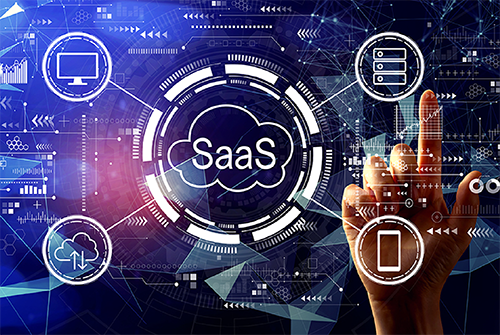
No doubt you've heard about SaaS, or Software as a Service, an increasingly common cloud computing delivery model that allows business application data to be accessed from any device with an internet connection and a web browser.
What you may not be following as closely is how SaaS, a relatively modern development, and EDI, a technology that's 40 years old, are braiding together to accelerate business in light of today's eCommerce-driven digital transformation movement.
To understand and appreciate the powerful benefits of "SaaS EDI," let's break it down into its component parts.
What is SaaS?
Software as a service (SaaS) is a common cloud computing delivery model that allows business application data to be accessed from any device with an internet connection and a web browser. Instead of downloading the software directly onto your laptop or desktop computer, SaaS offers a web-based model of delivery where software vendors host and maintain the servers, databases and the code that comprises the application.
This saves companies a tremendous amount of money since they no longer have to invest in expensive hardware to host the software. Additionally, instead of companies paying ongoing maintenance fees as well as a perpetual license, a SaaS model means they only pay an annual or monthly subscription fee, which includes the software license and support fees.
According to a recent integration survey, in response to the COVID-19 pandemic companies are putting even more strategic focus on SaaS solutions, with 96% of respondents saying they're now putting greater emphasis on integration solutions.
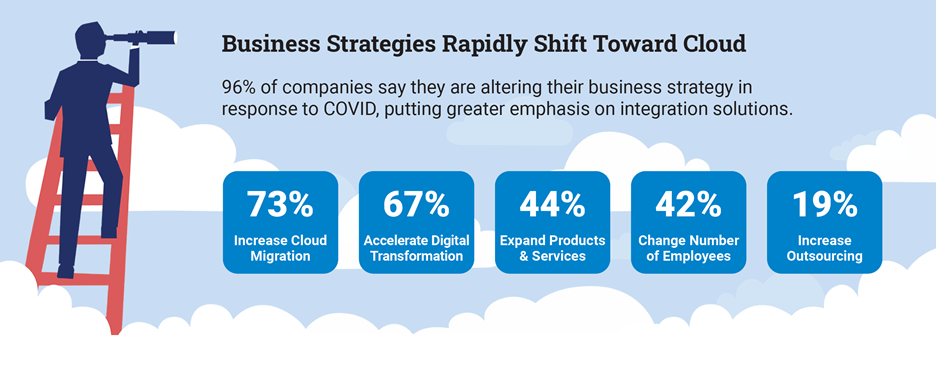
What is EDI?
Well, how about EDI? EDI stands for Electronic Data Interchange, and it's the world's most common method for electronically exchanging standardized business information between trading partners.
EDI allows the computer-to-computer exchange of business documents from one company to another, thereby enabling automated, paperless.
What is SaaS EDI?
So then, what happens when EDI meets the cloud? You get EDI Software as a Service i.e., you gain the self-service ability to control all things EDI via the more efficient -- and far less expensive and cumbersome -- cloud model.
Having that direct control means your internal backend applications (ERP, TMS, CRM, WMS, etc.) can swiftly and seamlessly connect with the EDI-enabled stakeholders you do business with across your ecosystem of trading partners.
This enables far more fluid B2B data and document flows throughout your revenue-critical end-to-end business processes, such as Order-to-Cash, Procure-to-Pay, or Load Tender-to-Invoice.
As eCommerce explodes and omnichannel fulfillment capabilities become more and more expected among your customers and partners, having a SaaS EDI solution in place can help your business stay competitive, scale more rapidly, and drive greater value throughout your multi-enterprise ecosystem, strengthening critical business relationships along the way.
This is good because "traditional" or on-premise EDI is fraught with challenges that are easily overcome with a SaaS EDI approach.
Challenges to On-Premise EDI
Here are some of the most common challenges enterprises face from "old school" EDI technologies, and why a move to a cloud-based SaaS EDI solution for B2B supply chains today makes so much sense:
Rising Costs
Maintaining outdated and legacy EDI solutions can be expensive. When an enterprise owns software and hardware for EDI, that also requires various financial and employee resources to manage all of it. Additionally, when something does go wrong, the hours and costs for maintenance quickly add up.
Scaling
Even though EDI is a ubiquitous, standardized data format, other members of your digital ecosystem likely have their own EDI requirements, which you must be able to support. Even standardized EDI requirements vary across numerous trading partners. Outdated, homegrown, or one-off EDI software will not be able to scale to support all the data requirements necessary to participate in your ecosystem as the business grows.
Lack of Automation
Traditional EDI mapping solutions are usually pretty rigid and can only perform specific EDI tasks because they can't natively integrate EDI with an ERP or CRM for end-to-end processing. Automating EDI transmission is one thing, but automatically transforming EDI into your required internal formal is quite another. Companies try to address it by throwing people and manual resources at the problem, but that's time-consuming, inefficient, and unscalable.
Complexity
Businesses can become overwhelmed with the number of errors their EDI transactions are throwing. Additionally, validating each segment in order to render a transaction as EDI compliant can prove challenging as well without the right technology. Now, compare these shortcomings against some of the clear advantages of SaaS EDI:
Cost Control
You'll experience lower upfront costs because your organization won't have to invest in all the servers, operating systems, and skilled resources that have been required in the past. Plus, you'll always know where your spending stands because you'll benefit from predictable ongoing costs based on subscription and usage rates.
Ease of Deployment
One of the biggest benefits of modern EDI cloud solutions for B2B integration is that they can integrate with other business systems and applications, such as ERP, to automate EDI order processing or entire end-to-end business cycles, like order to cash and procure to pay. Plus, aside from being easier and faster to deploy, there's really no software to maintain, as updates are "pushed" your way automatically from the cloud.
Accessibility & Scalability
Because your SaaS EDI solution is based in the cloud, you (as well as your key trading partners if desired) can access the solution at any time, from anywhere, using any device.
And ecosystem scalability is enhanced because you can onboard new trading partners up to 300% faster, often with pre-built connectors from a robust library of solutions to choose from.
Well, now that you know some of the pitfalls of "old school" EDI versus modern, cloud-based EDI solutions, what should you look for when evaluating a potential SaaS EDI vendor to partner with your organization?
Managed Service Providers -- Wolves in SaaS EDI Clothing?
One common misconception many companies hold is that a SaaS EDI solution is actually just another "Managed Services" offering.
Nothing could be further from the truth.
Managed Services basically means you're outsourcing EDI and have tasked a third party to run the solution for you, customizing the integrations you need, troubleshooting where necessary. Truth be told, many Managed Services providers have deep EDI expertise you wouldn't have to maintain on your IT staff.
Sure, that sounds good on paper, but in almost all cases you are still several steps removed from what's really happening day to day within your business-critical integration processes, many of which directly affect your company's revenue patterns. And delays in response time or limitations to your decision-makers visibility can be costly, in terms of money as well as a negative impact on valued trading partner relationships.
Under a Managed Services model or the in-house/on-prem/custom code option, somebody somewhere is generating code around the integrations. This means myriad things can (and do) veer off track because that's just the nature of software development.
But what if instead you had a self-service SaaS EDI solution deployed, and it included a robust library of pre-built connectors, developed to common standards and protocols, that you could implement at the click of a mouse, confident that all or most of the business logic required was already built-in?
Having such a "toolbox" in the cloud, always at the ready, would not only considerably speed up your ability to do business with just about anybody, but also would also give your company all the flexibility you need to outpace market disruption.
With faster trading partner onboarding you'd gain faster time to value for any new or existing business relationship, along with all the choice and direct control that comes with a self-service deployment model.
What to Look for in a SaaS EDI Solution
Getting down to brass tacks, here are some key things to look for when evaluating SaaS EDI vendor options:
Ability to gain insight into every business and EDI process
Visibility and insights are the core return of making an investment in a SaaS EDI solution. Not only will you be able to see all your EDI activity, get real-time message alerts, know what's happening across your ecosystem of trading partner views, you'll also quickly spot the trends that drive business intelligence so your team can take revenue-impacting action.
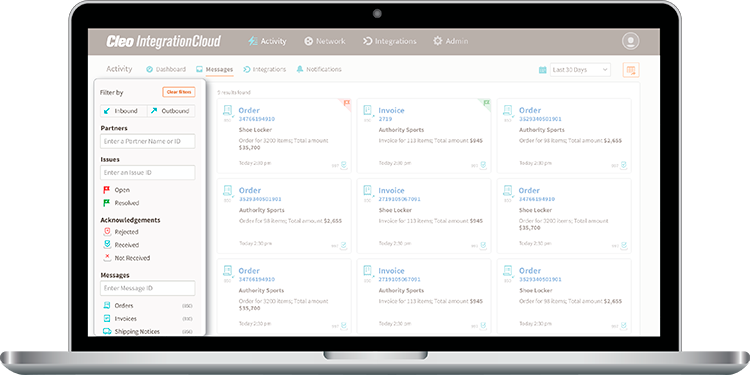
Persona-based dashboards
When you know you know, but hope and hunches are not knowing. Look for a SaaS EDI platform that helps you eliminate noise by zeroing in on the EDI data that matters most for anybody using the system. If you can define your views and empower users to take direct action on specific EDI transactions, your entire organization is marching in lockstep with integration activity.
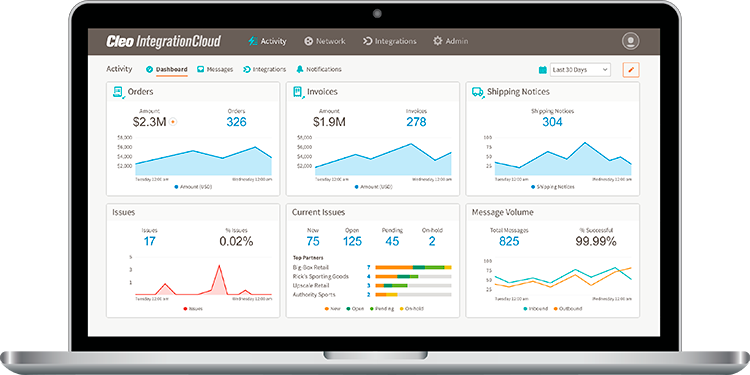
Self-service EDI visibility
Back to the notion of putting power in your own hands versus relying on a third party for integration oversight, true Saas EDI enables real-time insight and flexible collaboration with key trading partners on mutually agreed-upon terms.
And your solution will be all the more powerful if you can access operational insight, from any device or platform, precisely when you need it.
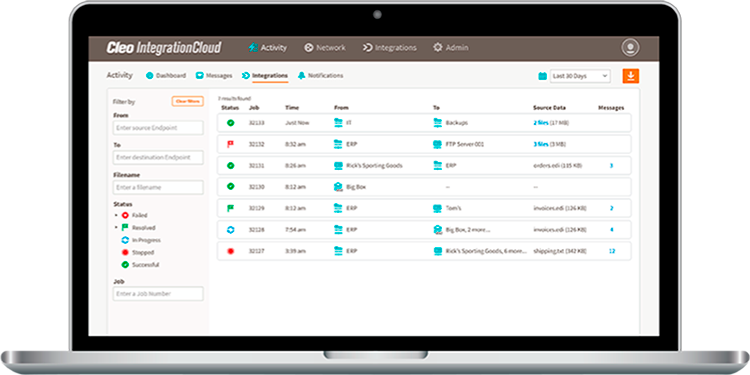
Proactive issue notifications
A SaaS EDI solution that gives you the ability to follow and share tickets, clearly tracking integration solution activity across your ecosystem, makes it easy to collaborate with your team and stay informed by enabling fully transparent operations.
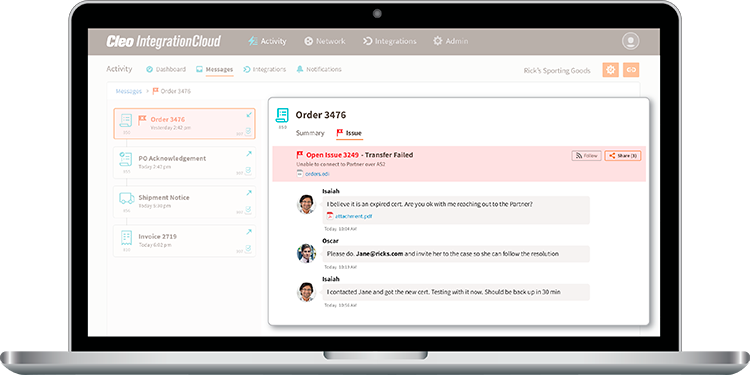
For a complete step-by-step strategy on choosing the right SaaS platform, read this (ungated) ultimate guide.
Eliminate EDI Complexity -- Cleo Integration Cloud
The good news is there is a SaaS EDI solution that can empower you with all these capabilities and more Cleo Integration Cloud (CIC). It's different from other B2B integration alternatives you may consider for improving supply chain agility and visibility because CIC is the only complete integration solution built as an "ecosystem integration" platform.
Specifically, only CIC delivers these unique capabilities:
API and EDI integration on the same platform -- Enable batch and real-time dataflows, power innovation, and ensure compliance
End-to-end business process visibility Real-time operational dashboards and actionable insights
Blend of Self and Managed Service -- Collaborative and transparent for unmatched control and agility
There you have it, everything you really need to know about how SaaS EDI puts you on the path to true ecosystem enablement and long-term business viability. It's a must-have strategy for today's rapidly changing, eCommerce-driven, cloud B2B world where customer and partner expectations are high, and where your supply chain's agility can make a huge competitive difference.
To learn more about Cleo Integration Cloud and its SaaS EDI features and capabilities, watch a demo.

About Cleo
